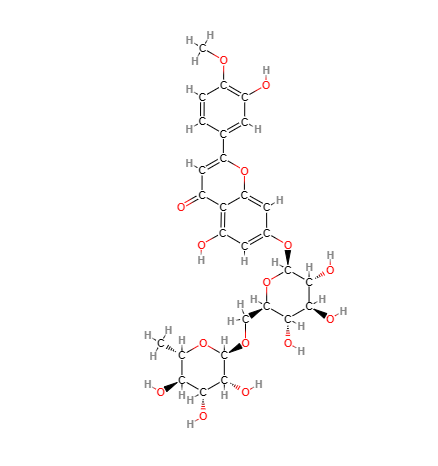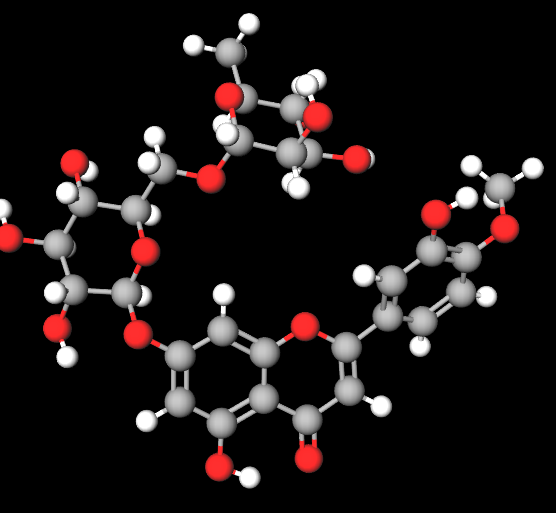Check the ingredients!
... live healthy!


| "Descrizione" by Al222 (19776 pt) | 2024-Feb-17 15:45 |
| Evaluation | N. Experts | Evaluation | N. Experts |
|---|---|---|---|
| 1 | 6 | ||
| 2 | 7 | ||
| 3 | 8 | ||
| 4 | 9 | ||
| 5 | 10 |
Diosmin is a bioflavonoid with specific pharmacological properties that make it effective in treating various venous and capillary disorders. Its action goes beyond merely reducing capillary permeability and increasing venous tone, touching on complex cellular and molecular mechanisms.
Antioxidant Action. Diosmin reduces oxidative stress in blood vessels (1) by neutralizing free radicals and protecting the vascular endothelium from oxidative damage. This antioxidant effect helps to maintain the integrity of blood vessels and prevent inflammation.
Anti-inflammatory Effect. It acts by modulating the activity of various inflammatory mediators, such as cytokines and metalloproteases, thereby reducing inflammation in the tissues surrounding blood vessels (2). This is particularly useful in the treatment of hemorrhoids and chronic venous insufficiency.
Improvement of Microcirculation. Diosmin enhances microcirculation by optimizing blood flow through capillaries and reducing blood viscosity (3). This facilitates tissue oxygenation and the removal of metabolic waste.
Therapeutic Applications. Beyond the treatment of venous insufficiency and hemorrhoids, diosmin has been explored for potential beneficial effects in other conditions, such as cardiovascular diseases, thanks to its antioxidant and anti-inflammatory properties.
Industrial Production Process
Sources. Although diosmin is industrially synthesized for pharmaceutical use, it is naturally present in small quantities in certain plants and foods, such as citrus fruits and herbs. Its synthetic form is optimized to ensure greater bioavailability and therapeutic efficacy.
Form and Color
Typically available in tablet or capsule form, diosmin is a pale orange crystalline powder.
Commercial Applications
Pharmaceutical Industry. Diosmin is widely used in pharmacology for the treatment of venous insufficiency, hemorrhoids, and varicose veins. It helps to improve vein tone and blood circulation.
Anti-inflammatory and Vasoprotective Properties. Offers anti-inflammatory benefits and helps protect blood vessels, reducing swelling and improving vascular health.
Dietary Supplements. Often included in supplements aimed at supporting circulatory and venous health.
Safety
Generally considered safe when used according to directions. However, as with all medications and supplements, it's advisable to consult a healthcare provider before use, especially during pregnancy or if you have pre-existing medical conditions.
 |  |
Molecular Formula C28H32O15
Molecular Weight 608.5 g/mol
CAS 520-27-4
UNII 7QM776WJ5N
EC Number 208-289-7
DTXSID4045892
Synonyms
Bibliografia_____________________________________________________________________
(1) Wójciak M, Feldo M, Borowski G, Kubrak T, Płachno BJ, Sowa I. Antioxidant Potential of Diosmin and Diosmetin against Oxidative Stress in Endothelial Cells. Molecules. 2022 Nov 25;27(23):8232. doi: 10.3390/molecules27238232. PMID: 36500323; PMCID: PMC9739697.
Abstract. Phlebotropic flavonoids, including diosmin and its aglycone diosmetin, are natural polyphenols widely used in the prevention and treatment of chronic venous insufficiency (CVI). As oxidative stress plays an important role in the development of pathophysiology of the cardiovascular system, the study aimed to investigate the protective effects of diosmin and diosmetin on hydrogen peroxide (H2O2)-induced oxidative stress in endothelial cells. The cells were pretreated with different concentrations of the flavonoid prior to the H2O2 exposure. The cell viability, the level of intracellular reactive oxygen species (ROS), the activity of cellular antioxidant enzymes-including superoxide dismutase (SOD), catalase (CAT), and glutathione peroxidase GPx-and the malondialdehyde (MDA) level were assessed. It was found that the H2O2-induced oxidative stress was ameliorated by diosmin/diosmetin in a concentration-dependent manner. The flavonoids restored the activity of cellular antioxidant enzymes and lowered the MDA level upregulated by the H2O2 exposure. These results indicate that diosmin and diosmetin may prevent oxidative stress in endothelial cells; therefore, they may protect against the development and progression of oxidative-stress-related disorders.
(2) Mitra R, Nersesyan A, Pentland K, Melin MM, Levy RM, Ebong EE. Diosmin and its glycocalyx restorative and anti-inflammatory effects on injured blood vessels. FASEB J. 2022 Dec;36(12):e22630. doi: 10.1096/fj.202200053RR.
Abstract. The endothelium, a crucial homeostatic organ, regulates vascular permeability and tone. Under physiological conditions, endothelial stimulation induces vasodilator endothelial nitric oxide (eNO) release and prevents adhesion molecule accessibility and leukocyte adhesion and migration into vessel walls. Endothelium dysfunction is a principal event in cardiovascular disorders, including atherosclerosis. Minimal attention is given to an important endothelial cell structure, the endothelial glycocalyx (GCX), a negatively charged heterogeneous polysaccharide that serves as a protective covering for endothelial cells and enables endothelial cells to transduce mechanical stimuli into various biological and chemical activities. Endothelial GCX shedding thus plays a role in endothelial dysfunction, for example by increasing vascular permeability and decreasing vessel tone. Consequently, there is increasing interest in developing therapies that focus on GCX repair to limit downstream endothelium dysfunction and prevent further downstream cardiovascular events. Here, we present diosmin (3',5,7-trihydroxy-4'-methoxyflavone-7-rhamnoglucoside), a flavone glycoside of diosmetin, which downregulates adhesive molecule expression, decreases inflammation and capillary permeability, and upregulates eNO expression. Due to these pleiotropic effects of diosmin on the vasculature, a possible unidentified mechanism of action is through GCX restoration. We hypothesize that diosmin positively affects GCX integrity along with GCX-related endothelial functions. Our hypothesis was tested in a partial ligation left carotid artery (LCA) mouse model, where the right carotid artery was the control for each mouse. Diosmin (50 mg/kg) was administered daily for 7 days, 72 h after ligation. Within the ligated mice LCAs, diosmin treatment elevated the activated eNO synthase level, inhibited inflammatory cell uptake, decreased vessel wall thickness, increased vessel diameter, and increased GCX coverage of the vessel wall. ELISA showed a decrease in hyaluronan concentration in plasma samples of diosmin-treated mice, signifying reduced GCX shedding. In summary, diosmin supported endothelial GCX integrity, to which we attribute diosmin's preservation of endothelial function as indicated by attenuated expression of inflammatory factors and restored vascular tone. © 2022 Federation of American Societies for Experimental Biology.
(3) Feldo M, Wójciak-Kosior M, Sowa I, Kocki J, Bogucki J, Zubilewicz T, Kęsik J, Bogucka-Kocka A. Effect of Diosmin Administration in Patients with Chronic Venous Disorders on Selected Factors Affecting Angiogenesis. Molecules. 2019 Sep 12;24(18):3316. doi: 10.3390/molecules24183316. PMID: 31547271; PMCID: PMC6767141.
Abstract. Diosmin is a natural compound with a wide range of biological activity, e.g., it improves lymphatic drainage, supports microcirculation, and increases venous tone, and venous elasticity, hence, it is applied in the pharmacotherapy of chronic venous disorders (CVD). The aim of this study was to assess the correlation between diosmin administration (2 × 600 mg daily) in patients suffering from CVD and the levels of selected factors influencing angiogenesis, which are involved in CVD pathophysiology. Thirty-five CVD patients were examined. Levels of plasma tumor necrosis factor alpha (TNF alpha), vascular endothelial growth factor (VEGF-A and VEGF-C); angiostatin, interleukin 6 (IL-6), fibroblast growth factor 2 (FGF2); and plasminogen (PLG) were measured with an Elisa assay before and after three months of diosmin administration. The clinical symptoms of CVD were monitored using ultrasound images, echo Doppler assay, visual analogue scale (VAS), and measurement of the leg circumference. The average content of TNF alpha, VEGF-C, VEGF-A IL-6, and FGF2 decreased after the therapy with diosmin in a significant manner; with p < 0.001, p < 0.05, p < 0.05, p < 0.01, and p < 0.01, respectively, and a significant (p < 0.05) increase in the plasma angiostatin level after the three-month treatment was found. A significant (p < 0.05) decrease in edema and the average leg circumference of the patients was observed after the therapy. Diosmin influences the angiogenic and inflammatory mechanisms involved in the pathophysiology of edema presented in patients with a different class of CVD.
| Evaluate |